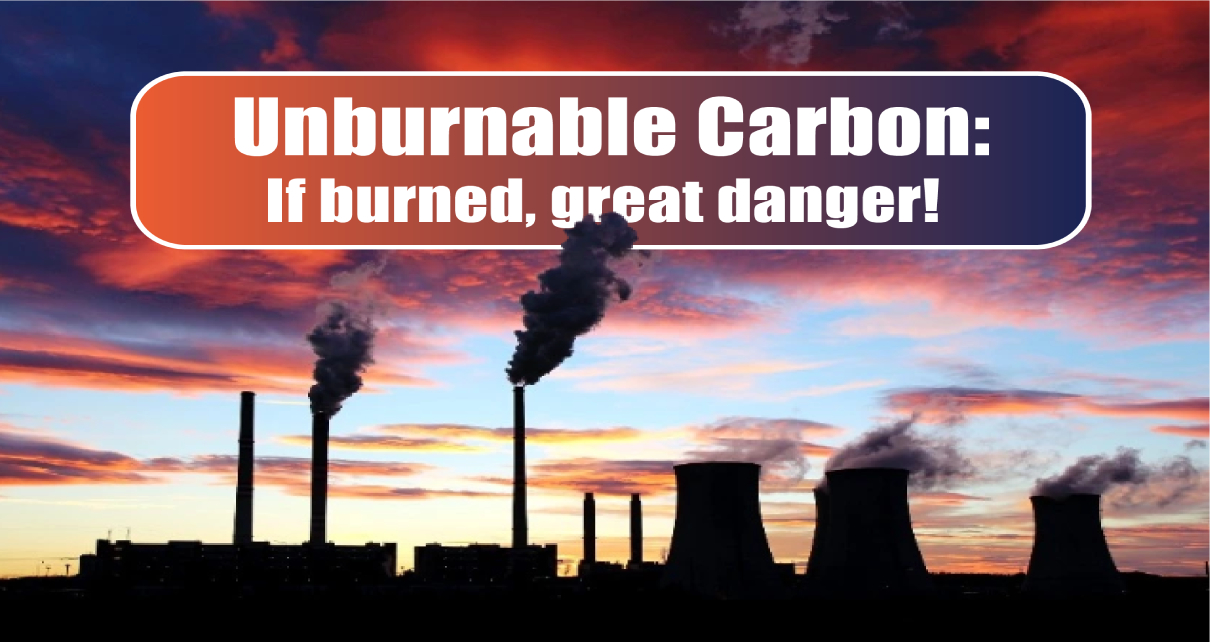
II. Background
2.1. Greenhouse effect
The greenhouse gases GHG effect works in the same way as the greenhouses do. Greenhouses are built especially in places with poor conditions for plants to grow, usually in icy places or where Sun’s rays are insufficient. They are built with glass roofs and windows to let the Sun’s rays be trapped inside the house to keep it warmer in winter or at night. Fig. 2.1.1 shows how a greenhouse works.

Thus, the greenhouse effect is the phenomenon that traps the Sun’s rays in the Earth’s atmosphere, not letting them bounce back into space, keeping warm the planet at an ideal global average temperature allowing life on Earth. Fig. 2.1.2. shows the greenhouse effect on the Earth.

However, due to human activity and the development of the industrial industry, the amount of gases, such as CO2, methane, among others in the atmosphere that causes this phenomenon, has become alarmingly large over a very short time. The increase in the proportion of greenhouse gases above normal concentrations mainly causes an increase in the ideal global average temperature.
Consequently, the more greenhouse gases present in the atmosphere, the hotter the Earth will be. For example, the planet Venus has more than 90% carbon dioxide present in its atmosphere, and its surface temperature is more than 400 °C (Edinburgh University, n.d.)
2.2. The carbon cycle
It is well known that plants absorb carbon dioxide from the ambient, reducing its amount in the atmosphere. However, unlike plants, animals and human beings breathe in oxygen, which is vital for life, but breathe out carbon dioxide back into the atmosphere. In such a manner, the plants’ carbon goes back to the atmosphere to start the cycle again.
Nevertheless, the carbon cycle is larger than the one described above. It also includes a vast amount of carbon in rocks, such as coal, which is 60-80% carbon. Similarly, many other rocks also contain a certain percentage of carbon, indicating that the amount of carbon stored in these rocks is enormous. Estimations indicate that the amount of carbon stored in these rocks is around two thousand times or higher than the quantities present in the atmosphere. Fig. 2.2.1 shows the carbon cycle.
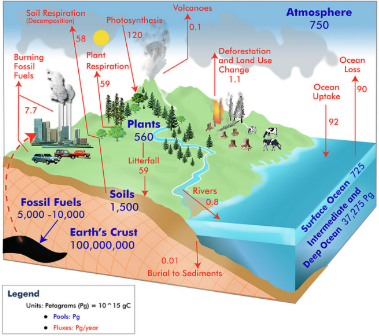
As seen from Fig. 2.2.1, a small amount of carbon between the ocean-atmosphere-biosphere cycle and the geological one is transferred. Sediments, which are deposited in oceans, also contain carbon. These sediments, such as sand or mud, become rocks once they are buried. Certain amounts of carbon stored in these rocks are caught, for example, in the uplift of mountains and worn away when the carbon goes back to the atmosphere and oceans. Thus, the cycle begins once again.
2.3. Fossil fuel reserves
Fossil fuels are natural resources that consist of coal, oil, and natural gas. Collectively, they provide over 80% of the world’s primary energy. Today’s energy markets are dominated by the crucial increase in energy demand due to the solid economic growth in countries like China and India (Prof. Bharat Raj Singh, 2012)
Energy global consumption grew by 2,3% in 2018, nearly twice the average rate of growth since 2010, driven by the observed robust economy (Millennium Alliance for Humanity & the Biosphere MAHB, 2019). The electricity demand itself grew by 4% in 2018. Due to the rapid growth in global energy demand, electricity is being pushed to play a significant role in total energy consumption.
According to the International Energy Agency (IEA), countries like the U.S.A., Russia, and China have jointly produced about 30% and consumed 40% of total world energy. According to IEA, fossil fuels will remain the primary energy source globally at least until 2030, and their use is expected to grow in volume. However, these natural resources are limited.
Fig. 2.3.1 shows the energy reserves in billion tonnes of oil equivalent (Btoe) over time.
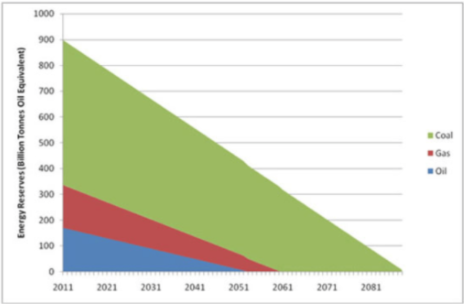
As shown in Fig. 2.3.1, it can be appreciated that fossil fuel reserves will no longer exist. By 2052, 2060, and 2090, oil, gas, and coal reserves will be depleted, respectively. However, according to the annual report of the oil giant company British Petroleum BP, the Earth has nearly 1.688 trillion barrels of crude, which will last 53.3 years at current extraction rates (Christian Science Monitor, 2014).
2.3.1. Oil reserves
Global oil demand grew by 1.3% in 2018 (Millennium Alliance for Humanity & the Biosphere MAHB, 2019). Today, oil supplies about 40% of the world’s energy and 96% of its transportation. From all the oil barrels estimated, 6% are located in North America, 9% in Central and Latin America, 2% in Europe, 4% in the Asia Pacific, 7% in Africa, 6% in the former Soviet Union. The countries with more oil reserves in the world are Saudi Arabia (25%), Iraq (11%), Iran (8%), UAE (9%), Kuwait (9%), and Libya (2%) (Institute for the Analysis of Global Security, n.d.)
Fig. 2.3.1.1 shows oil reserves in distinct parts of the world.
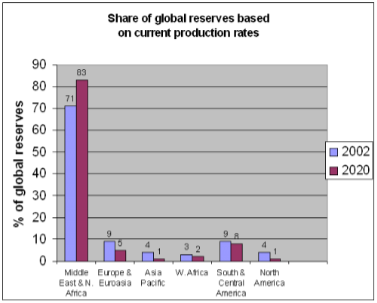
As seen from Fig. 2.3.1.1, the countries with a high amount of oil reserves are Middle East countries, being the only ones capable of increasing their oil reserves. Therefore, if oil production continues at today’s rate, many of the largest 2002 producers will soon cease to play a relevant role in the oil market.
2.3.2. Natural gas reserves
The amount of natural gas reserves depends on various factors. For example, it depends on the production and consumption rates, on how much coal and oil reserves will be available. However, studies estimate that natural gas will last 40 to 52 years (Better Meets Reality, 2021).
The world’s natural gas consumption is more than 17 thousand cubic feet per capita every year (based on the world population in 2017) (Worldometer, n.d.). Moreover, as of January 1st, 2020, the world proved gas reserves were estimated to be more than 7 thousand trillion cubic feet (Tcf), according to the International Energy Agency (IEA) (Energy Information Administration EIA, 2021)
Fig. 2.3.2.1 shows the historically proven gas reserves over time.
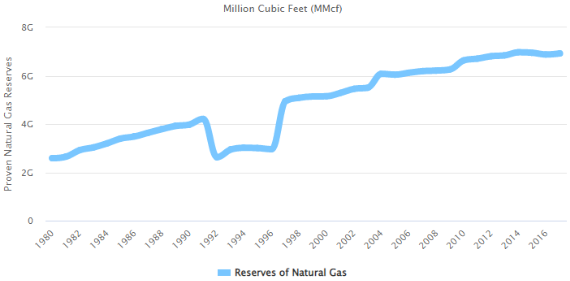
It is essential to point out the difference between proven and recoverable natural gas reserves. The proven reserves refer to the actual (total) amount of reserves. In contrast, the term “recoverable” refers to the natural gas reserves which can be mined with mining technology after considering accessibility constraints and recovery factors (Better Meets Reality, 2021)
According to the Annual Energy Outlook 2019 of the U.S. Energy Information Administration, more than 2 thousand trillion cubic feet (Tcf) of technically recoverable resources of dry natural gas were estimated in the U.S (Millennium Alliance for Humanity & the Biosphere MAHB, 2019).
2.3.3. Coal reserves
Coal is the third type of fossil fuel and the oldest. According to the IEA, the global coal consumption increased by 1% or 50.4 megatons of coal equivalent (Mtce) (Millennium Alliance for Humanity & the Biosphere MAHB, 2019). Moreover, the coal demand in the world is up to 0.7% in 2018 (S&P Global, 2019).
In 2016, the estimated of coal reserves on the planet was more than 1 million tonnes, equivalent to about 130 times its annual consumption. Coal will be depleted in more than 130 years at current consumption levels.
Fig. 2.3.3.1. shows the global coal reserves over time until 2017.

Views: 1
Notifications
Receive the new articles in your email







